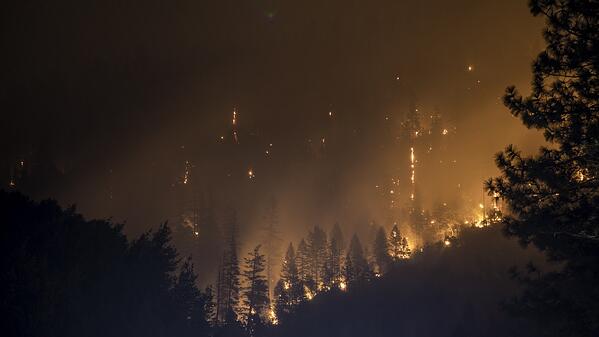Posted by Michelle Vignault
Invasive plants are non-native species that have been introduced intentionally or accidently. Once established, these plants are harmful in many different ways and cause numerous problems that vary depending on the species, location, land use, and desirable vegetation. The negative impacts can range from poor aesthetics to altering the utility and function of ecosystems.

One of the most detrimental effects of invasive plants is the impact on fire. Certain species may establish or spread after fires have eliminated desirable vegetation. Invasive plants may also exacerbate the rate, spread, and intensity of wildfires. These impacts may irreparably change ecosystems and increase the costs associated with land management.
Land Management
Controlling Fires
There was a time when land managers thought fire was ecologically detrimental. So land managers always controlled fire; natural and man-made. “Smoky Bear” was part of marketing campaign to engage the public into helping stop fires. We now know that controlling fire has had several harmful consequences. Fire is a natural process that many ecosystems have not only adapted to, but, require. In the absence of frequent, low-intensity natural fires, ecosystems accumulated excessive fuel loads due to uncontrolled weedy plant growth. When fire does inevitably occur, the impact is exacerbated due to increased fuel from excessive plant growth. Wildfires cause extensive and permanent irreversible damage and provide opportunities for non-native plant invasions.
In the Southeastern United States “longleaf-wire grass” ecosystems are dependent on fire. These pyrogenic systems are adapted to frequent lighting strikes. Wire grass burns at a temperature that allows for normal fuel reduction from the removal of excess weedy growth and breaks longleaf pine seed dormancy. Thus, natural fire allows for the regrowth of new pine trees and removes excessive plant growth so a new cycle of wire grass regrowth can occur. Unfortunately, the invasive of cogongrass (Imperata cylindrica) has altered this natural cycle of events. If cogongrass is introduced into this system, often following disturbance cause by, fire, lodging, or construction; rapid spread occurs. Cogongrass significantly increases the fuel load of the system and consequently fire intensity. Cogongrass increases the temperature of fire enough to kill pine seed and wire grass. This change in fire characteristics, perpetuates the continued spread of cogongrass and ultimately allows for the formation of monotypic stands devoid of any plant of animal diversity.
In the Western United States, a similar story of plant invasion and fires severity has unfolded. Two invasive grass species have invaded shrubland ecosystems replacing native plant species. These non-native plants reduce biodiversity and alter fire characteristics from a required natural occurrence to irreparable ecosystem damage. Cheatgrass (Bromus tetorum) and Red brome (Bromus ruben) outcompete native plants and can dominate large tracts of land. Once the native plant community has been replaced dependent animal population disappear. Without natural food or protection, grazing animals are soon displaced. Predatory animals, such as golden eagles, may also decline in the absence of prey species. This unnatural cycle of events results from the increase in fire frequency and intensity caused by the spread of the two invasive grass species.

Another link between fire and invasive plants occurs throughout the United States. In developed communities where some forested natural areas have been retained, the natural cycle of fire and regrowth has been disrupted. When homes and business are interspersed within the natural ecosystem, fire is often once again prevented due to public intolerance. This is understandable, because of fear of fire and smoke. Recent fires in the western United States reflect the difficultly associated with proper vegetation and fire management. When forested areas are broken into small discontinuous pockets which creates an “edge effect”. At the edge of a wooded area light is able to penetrate that would not occur in a larger forested area. This increased light intensity allows for the unnatural invasion of weedy plants. Many of the plant species that infest “edges” of woody areas are vines such as the invasive plants kudzu, Japanese climbing fern, old world climbing fern and air potato. All of these unwanted plants cause a significant increase in the fuel load of these areas. The solution is to control this excessive vegetation chemically or with “prescribed burns.” Without proper maintenance management, the inevitable eventually occurs-fire: either caused by man or lightening. Because the invasion of excessive vegetation has a 3-dimensional characteristic, spreading both horizontal and vertical, the fire characteristics make control very difficult. This is because the excessive fuel is distributed along the surface of the land and into to the forest canopy.
Thus, fire and invasive plants are inexorably linked:
1. Fire can promote plant invasions through the removal of plant competition predisposing land to invasions
2. Fire has to be used as a cost-effective tool to manage unwanted vegetation including invasive plants
3. Once established invasive plant change fire characteristics.
Prevention
Integrated Solutions
There are several solutions to avoid the aforementioned problems. Prevent the introduction of non-native plants or rapidly eradicate if identified–both of which are impossible. The use of vegetation management tools such as herbicides, biological controls, physical removal and/or natural or prescribed fire. Fire is by far the cheapest and preferred method but its use has consequences especially when invasive plants are involved. No matter what approach is embraced, cost, efficacy, policy, practicality, public perception will all need to be part of the solution.
Because the costs of invasive plant and fire management are exorbitant, any and all techniques and technologies that can improve control and reduce costs must be embraced. Clearion has proven to be an effective technology to improve how to efficiently solve just such problems. The technology has been developed to help effectively manage, manmade, and natural components, of large and dynamic ecosystems.
The process starts with this cloud based software providing customers with a customized system to fully and precisely map invasive plants and/or areas susceptible to invasive due to recent fires. Next, all aspect of work (time, location, type of work, weather conditions) are documented. Impacts of treatments/inputs etc., are then characterized. Information is archived and retrievable at any time or place because the input or retrieval of information is managed remotely via iPhone, iPad or computer. Learn more at www.clearion.com
